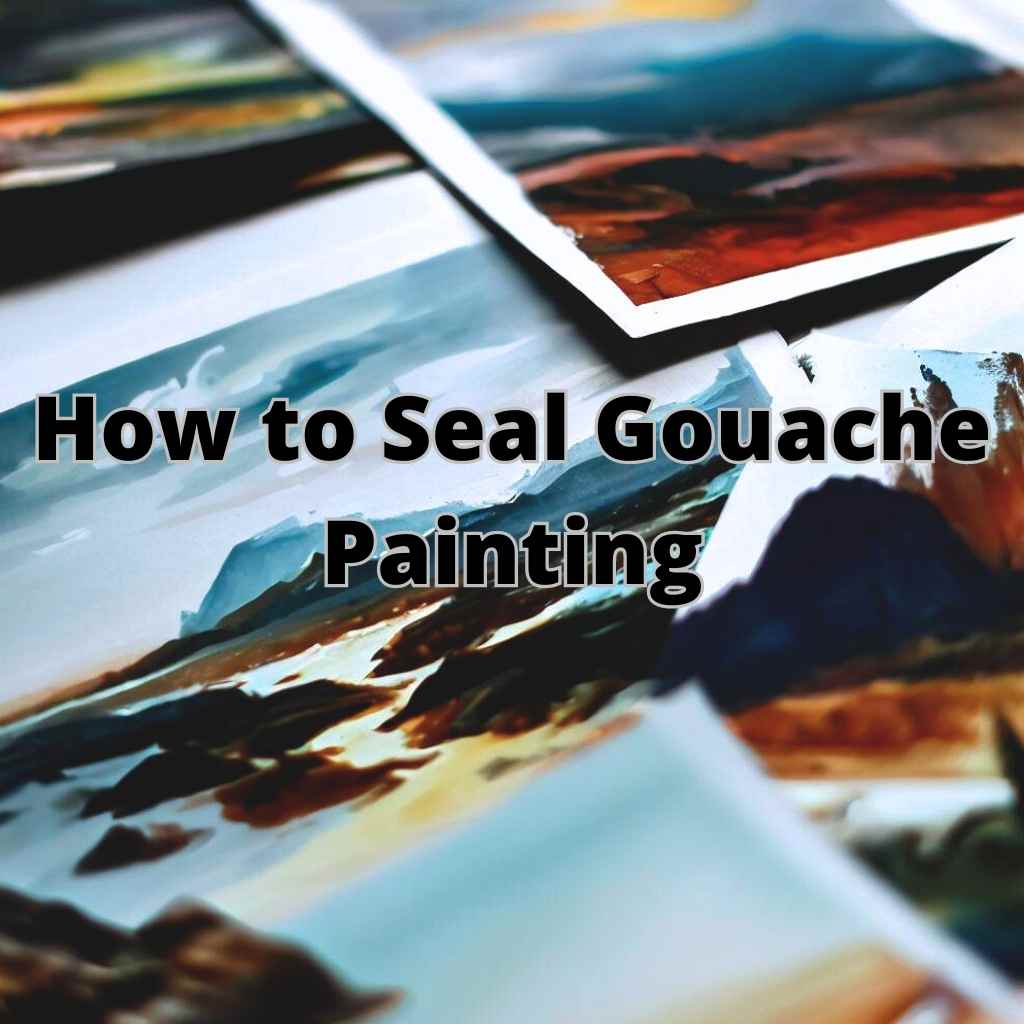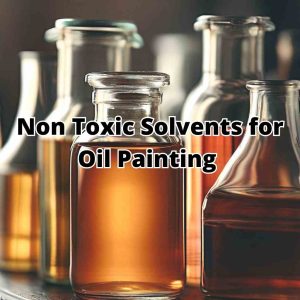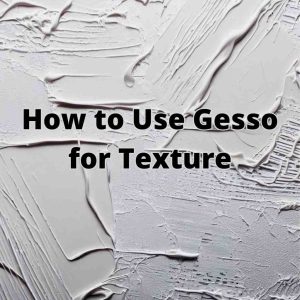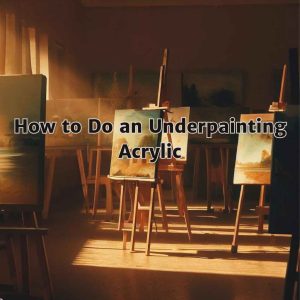If you’re an artist who loves working with gouache paints, you know how important it is to protect your work and ensure its longevity. One way to do this is by sealing your gouache painting.
However, many artists may be unsure of how to seal gouache painting properly, leading to potential damage and disappointment.
That’s why in this blog, we will explore how to seal gouache paintings, step-by-step instructions on the sealing process, as well tips for post-sealing care and troubleshooting common issues.
So, let’s get started!
Preparing Your Gouache Painting for Sealing
Before you begin sealing your gouache painting, it is important to prepare the painting properly. Here are the steps to follow:
- Dry Completely: Ensure the painting is fully dry, which may take several hours or days.
- Remove Dust: Gently use a soft brush or microfiber cloth to clear any debris.
- Fix Imperfections: Touch up any mistakes with gouache paint.
- Mask Edges: Apply masking tape around the painting’s border to protect the edges from the sealer.
Choosing the Right Sealer for Your Gouache Painting
Choosing the right sealer for your gouache painting is important to ensure that it is properly protected and preserved. Here are some things to consider when selecting a sealer:
Types of sealers available
When it comes to sealing your gouache painting, you’ll want to choose the right type of sealer to ensure that your artwork is protected and looks as beautiful as possible. There are several types of sealers available, and each has its own unique properties and benefits.
Acrylic sealers
Acrylic sealers are a popular choice for sealing gouache paintings because they are water-resistant, durable, and dry clear. They also do not yellow over time, making them ideal for preserving the original colors of your painting.
Additionally, acrylic sealers are available in different finishes, such as gloss, matte, and satin, allowing you to choose the finish that best suits your painting.
Gloss, matte or satin finish
Gloss, matte, and satin finishes are the most common finishes for sealers. Gloss finishes provide a shiny, reflective surface that enhances the vibrancy of the colors in your painting.
Krylon UV ARCHIVAL VARNISH is a glossy spray varnish that offers non-yellowing protection.
Golden Archival Varnish Gloss is another spray varnish which is removable with GOLDEN MSA Solvent.
Matte finishes, on the other hand, provide a non-reflective, dull surface that creates a more subdued and natural appearance. Golden Archival Varnish Spray matte is a recommended sealer for a matte look.
If you’re looking for a liquid varnish, Liquitex BASICS Matte Varnish is recommended.
Satin finishes offer a compromise between the two, providing a slightly reflective, soft sheen that is not as shiny as gloss finishes but not as dull as matte finishes.
Krylon Satin Finish is a spray and Liquitex Professional Satin Varnish is a liquid varnish that gives satin looks to a painting.
Cold wax medium
Another type of sealer that can be used for gouache paintings is Cold Wax Medium. Cold Wax Medium is a mixture of beeswax, resin, and solvent that dries to a hard, protective surface.
It can be used to seal and make the painting waterproof, and it provides a unique texture that can enhance the painting’s overall appearance.
Jacquard Dorland’s Wax Medium would be a good choice to seal a gouache painting.
Selecting the right type of sealer for your painting
Choosing the right type of sealer is an important step in preserving the longevity and appearance of your gouache painting. With so many types of sealers available, it can be overwhelming to decide which one to choose.
Here are a few things to take into consideration while choosing a sealer:
- Consider the specific characteristics of the sealer, such as its drying time, durability, and level of gloss or sheen.
- Take into account the specific needs of your painting and the environment in which it will be displayed, such as exposure to direct sunlight or high levels of humidity.
- Choose a sealer with UV protection or moisture resistance if your painting will be exposed to direct sunlight or high levels of humidity.
- Experiment with different types and brands of sealers until you find the one that provides the desired level of protection and appearance for your painting.
- Read the manufacturer’s instructions carefully and follow them closely when applying the sealer.
- Test the sealer on a small, inconspicuous area of your painting before applying it to the entire surface to ensure that it does not damage or alter the colors of your painting.
How to Seal Gouache Painting: Application
While sealing a gouache painting, there are a few steps to follow:
Read the manufacturer’s instructions carefully
Reading the manufacturer’s instructions carefully is crucial before applying the sealer to your gouache painting. This will help you to understand the specific requirements and recommendations for the sealer you are using.
Ensure that you have all the necessary equipment and materials before you begin to apply the sealer to your painting.
Application method
There are two primary methods for applying sealer to your gouache painting:
Using a spray
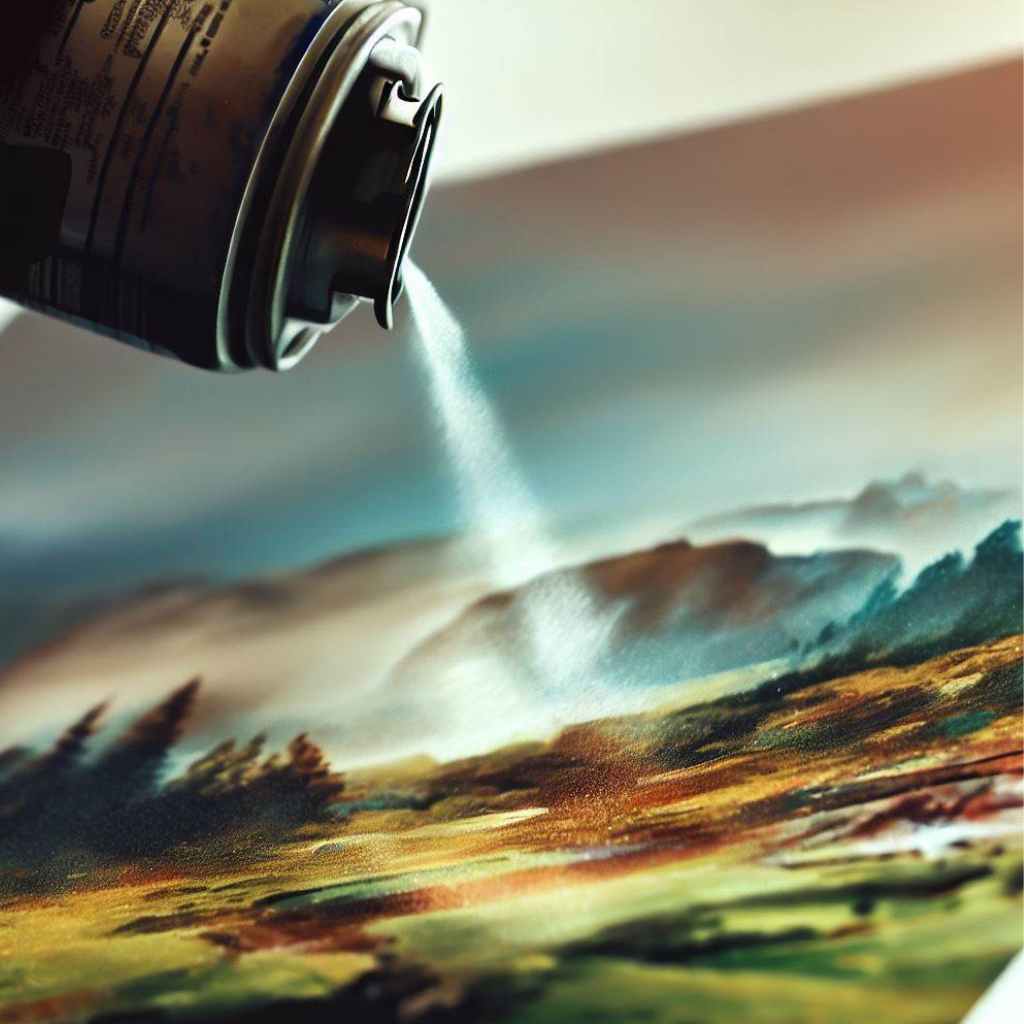
Using a spray varnish
When using a spray application method, it is important to hold the can at a consistent distance from the painting and to apply the sealer in even, sweeping motions.
Start spraying off to the side of the painting and move in a fluid motion from left to right or right to left. Keep the can moving and avoid spraying too heavily in one area, as this can lead to drips and uneven coverage.
Using a brush
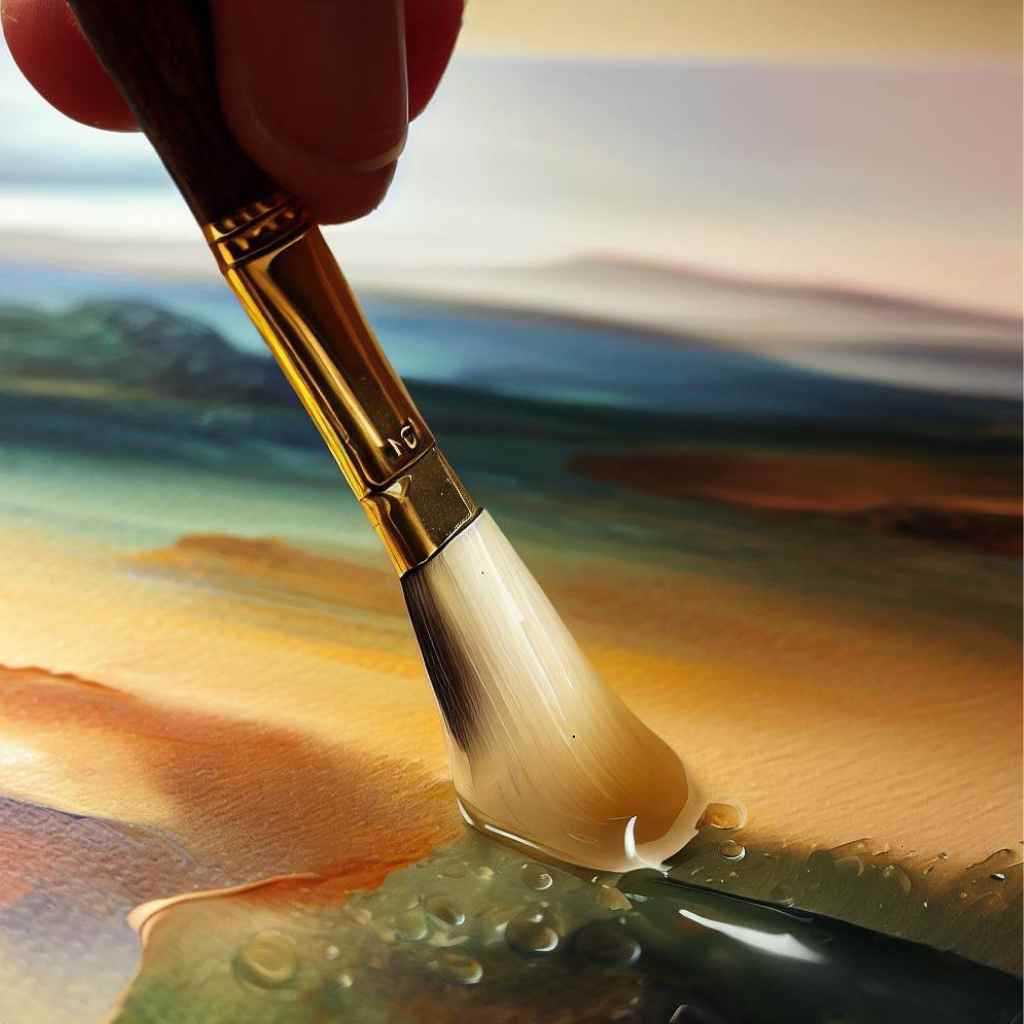
Applying sealer with a soft brush
When using a brush application method, it is important to use a soft-bristled brush and to apply the sealer in even, light strokes. Begin by brushing the sealer on the edges of the painting, working your way inward.
Be sure to use smooth strokes and avoid over-brushing, as this can cause the sealer to clump or streak. It is also important to brush in a well-lit area to ensure that the coverage is even and consistent.
Brushing allows for more control over the application, but it can take longer than spraying and requires a bit more attention to detail.
Applying cold wax medium as a sealer
To use the cold wax medium as a sealer, first, ensure that the painting is completely dry and free of any debris.
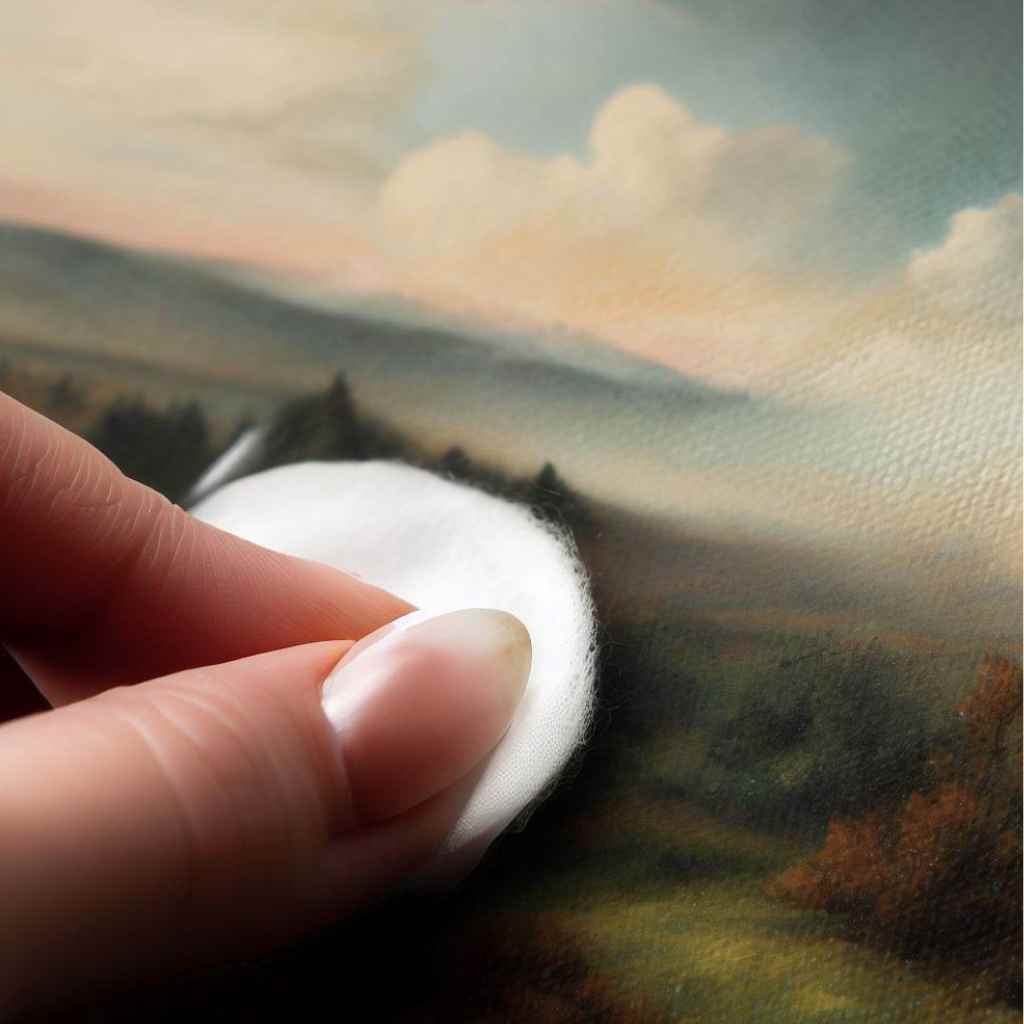
Applying cold wax medium using a cotton pad
Next, apply a thin layer of the cold wax medium to the painting using a cotton pad, soft tissue or a soft towel. Rub it slowly on the painting.
Allow the layer to dry completely and you will get a bit shiny look. It also creates a soft sheen look.
Avoiding over-application or under-application
It is important to apply the sealer evenly, avoiding over-application or under-application.
Over-application can result in a tacky or cloudy appearance, while under-application may not provide enough protection for the painting. Be sure to apply the sealer in thin, even coats, allowing each coat to dry completely before applying the next.
If you do notice any bubbles or drips forming while applying the sealer, try to smooth them out gently with a soft brush or cloth before the sealer dries. This can help prevent any unwanted texture or marks on the surface of the painting.
For cold wax medium, it is important to note that using too much of it can alter the colors of the gouache painting, so it is recommended to test the medium on a small, inconspicuous area of the painting before applying it to the entire surface.
Drying and Curing Your Sealed Gouache Painting
After you’ve applied the sealer to your gouache painting, it’s important to allow it to dry and cure properly to ensure maximum protection and longevity of your artwork.
Most sealers will dry within a few hours, but some may take up to 24 hours or more. To speed up the drying and curing process, you can use a fan or a dehumidifier to increase air circulation and reduce humidity in your workspace.
However, it’s important to avoid exposing the painting to excessive heat or direct sunlight, as this can cause the sealer to bubble or crack.
It’s also important to avoid touching or moving the painting until the sealer is fully cured to prevent any damage or smudging.
Post-Sealing Care for Your Gouache Painting
After sealing your gouache painting, it is important to take proper care of it to ensure its longevity and appearance.
- Avoid touching the surface of the painting to prevent damage from oils and fingerprints.
- Protect the painting from humidity and direct sunlight to avoid fading, yellowing, or mold growth.
- Consider displaying the painting in an area that does not receive direct sunlight, or framing it with UV-protective glass.
- Clean the painting carefully with a soft, lint-free cloth if necessary.
- Proper storage is crucial for maintaining the quality of your gouache painting. Avoid stacking or leaning paintings against each other, and store the painting in a cool, dry place.
- Ideally, lay the painting flat or prop it up against a wall to prevent warping or bending.
- Cover the painting with a protective sheet or tissue paper to prevent dust from settling on the surface.
Troubleshooting Common Issues
Some common issues may arise when sealing a gouache painting and provide some solutions to fix them.
- Sealer bubbles or cracks: One common issue is the formation of bubbles or cracks in the sealer after it has dried. This can be caused by applying the sealer too thickly or not allowing enough drying time between coats.
To fix this issue, gently sand the affected area with fine-grit sandpaper and apply a thin, even coat of sealer. - Sealer discoloration: Another issue that may arise is discoloration of the sealer, which can occur if the sealer is not compatible with the gouache paint or if it has been exposed to heat or sunlight.
To avoid this issue, choose a sealer that is compatible with gouache paint and store your painting in a cool, dry place away from direct sunlight. - Sealer dripping or running: Another issue that may arise is discoloration of the sealer, which can occur if the sealer is not compatible with the gouache paint or if it has been exposed to heat or sunlight.
To avoid this issue, choose a sealer that is compatible with gouache paint and store your painting in a cool, dry place away from direct sunlight.
FAQs
- Can I use hairspray to seal gouache paintings?
Hairspray is not recommended as a sealant for gouache paintings as it can cause yellowing, cracking, and damage to the artwork over time. It is best to use a professional-grade sealant designed specifically for use with gouache paint.
- Can I paint over a sealed gouache painting?
Yes, you can paint over a sealed gouache painting as long as the sealant has completely dried and cured. Make sure to lightly sand the surface of the painting and clean it thoroughly before applying new paint.
- Can I use a fixative instead of a sealant on gouache paintings?
Fixatives are not recommended as a substitute for sealants on gouache paintings. Fixatives are designed to fix dry media such as charcoal or pastel to the paper surface and may not provide adequate protection for gouache paint.
- Can I use a hairdryer to speed up the drying process?
Using a hairdryer on gouache paintings is not recommended as it can cause the paint to dry too quickly and may result in cracking or other damage. It is best to let the painting dry naturally at room temperature.
- How long does a sealed gouache painting last?
A properly sealed gouache painting can last for many years if it is stored in a cool, dry place and protected from direct sunlight and other environmental factors. However, the lifespan of a painting may depend on the quality of the materials used, the sealing process, and how well it is cared for over time.
Final Thoughts
Knowing how to seal gouache painting is essential in protecting your artwork and ensuring that it lasts for a long time.
The process may seem daunting at first, but with the right tools and techniques, it can be done easily and effectively. Always remember to prepare your painting surface properly, choose the right sealer for your project, and apply the sealer in thin, even coats.
By following the simple steps outlined in this article, you can safeguard your gouache paintings from dust, moisture, and other environmental factors that can damage the artwork.
Don’t forget to also consider the different finishes that can enhance the overall appearance of your painting. With a little bit of patience and practice, sealing your gouache paintings can become a routine part of your creative process.
Understanding how to seal gouache paintings is essential, but don’t miss tips on how to take care of gouache paint to keep your materials in perfect shape.

